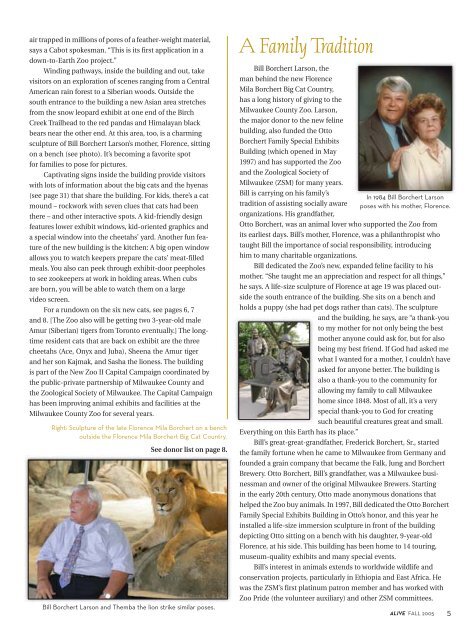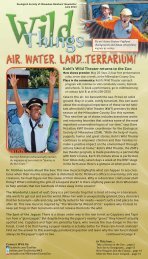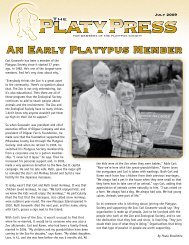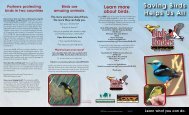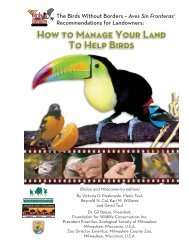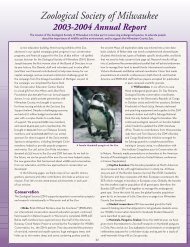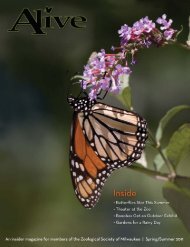AliveFall 2005 - Zoological Society of Milwaukee
AliveFall 2005 - Zoological Society of Milwaukee
AliveFall 2005 - Zoological Society of Milwaukee
Create successful ePaper yourself
Turn your PDF publications into a flip-book with our unique Google optimized e-Paper software.
air trapped in millions <strong>of</strong> pores <strong>of</strong> a feather-weight material,<br />
says a Cabot spokesman. “This is its first application in a<br />
down-to-Earth Zoo project.”<br />
Winding pathways, inside the building and out, take<br />
visitors on an exploration <strong>of</strong> scenes ranging from a Central<br />
American rain forest to a Siberian woods. Outside the<br />
south entrance to the building a new Asian area stretches<br />
from the snow leopard exhibit at one end <strong>of</strong> the Birch<br />
Creek Trailhead to the red pandas and Himalayan black<br />
bears near the other end. At this area, too, is a charming<br />
sculpture <strong>of</strong> Bill Borchert Larson’s mother, Florence, sitting<br />
on a bench (see photo). It’s becoming a favorite spot<br />
for families to pose for pictures.<br />
Captivating signs inside the building provide visitors<br />
with lots <strong>of</strong> information about the big cats and the hyenas<br />
(see page 31) that share the building. For kids, there’s a cat<br />
mound – rockwork with seven clues that cats had been<br />
there – and other interactive spots. A kid-friendly design<br />
features lower exhibit windows, kid-oriented graphics and<br />
a special window into the cheetahs’ yard. Another fun feature<br />
<strong>of</strong> the new building is the kitchen: A big open window<br />
allows you to watch keepers prepare the cats’ meat-filled<br />
meals. You also can peek through exhibit-door peepholes<br />
to see zookeepers at work in holding areas. When cubs<br />
are born, you will be able to watch them on a large<br />
video screen.<br />
For a rundown on the six new cats, see pages 6, 7<br />
and 8. [The Zoo also will be getting two 3-year-old male<br />
Amur (Siberian) tigers from Toronto eventually.] The longtime<br />
resident cats that are back on exhibit are the three<br />
cheetahs (Ace, Onyx and Juba), Sheena the Amur tiger<br />
and her son Kajmak, and Sasha the lioness. The building<br />
is part <strong>of</strong> the New Zoo II Capital Campaign coordinated by<br />
the public-private partnership <strong>of</strong> <strong>Milwaukee</strong> County and<br />
the <strong>Zoological</strong> <strong>Society</strong> <strong>of</strong> <strong>Milwaukee</strong>. The Capital Campaign<br />
has been improving animal exhibits and facilities at the<br />
<strong>Milwaukee</strong> County Zoo for several years.<br />
Right: Sculpture <strong>of</strong> the late Florence Mila Borchert on a bench<br />
outside the Florence Mila Borchert Big Cat Country.<br />
See donor list on page 8.<br />
Bill Borchert Larson and Themba the lion strike similar poses.<br />
A Family Tradition<br />
Bill Borchert Larson, the<br />
man behind the new Florence<br />
Mila Borchert Big Cat Country,<br />
has a long history <strong>of</strong> giving to the<br />
<strong>Milwaukee</strong> County Zoo. Larson,<br />
the major donor to the new feline<br />
building, also funded the Otto<br />
Borchert Family Special Exhibits<br />
Building (which opened in May<br />
1997) and has supported the Zoo<br />
and the <strong>Zoological</strong> <strong>Society</strong> <strong>of</strong><br />
<strong>Milwaukee</strong> (ZSM) for many years.<br />
Bill is carrying on his family’s<br />
In 1984 Bill Borchert Larson<br />
tradition <strong>of</strong> assisting socially aware poses with his mother, Florence.<br />
organizations. His grandfather,<br />
Otto Borchert, was an animal lover who supported the Zoo from<br />
its earliest days. Bill’s mother, Florence, was a philanthropist who<br />
taught Bill the importance <strong>of</strong> social responsibility, introducing<br />
him to many charitable organizations.<br />
Bill dedicated the Zoo’s new, expanded feline facility to his<br />
mother. “She taught me an appreciation and respect for all things,”<br />
he says. A life-size sculpture <strong>of</strong> Florence at age 19 was placed outside<br />
the south entrance <strong>of</strong> the building. She sits on a bench and<br />
holds a puppy (she had pet dogs rather than cats). The sculpture<br />
and the building, he says, are “a thank-you<br />
to my mother for not only being the best<br />
mother anyone could ask for, but for also<br />
being my best friend. If God had asked me<br />
what I wanted for a mother, I couldn’t have<br />
asked for anyone better. The building is<br />
also a thank-you to the community for<br />
allowing my family to call <strong>Milwaukee</strong><br />
home since 1848. Most <strong>of</strong> all, it’s a very<br />
special thank-you to God for creating<br />
such beautiful creatures great and small.<br />
Everything on this Earth has its place.”<br />
Bill’s great-great-grandfather, Frederick Borchert, Sr., started<br />
the family fortune when he came to <strong>Milwaukee</strong> from Germany and<br />
founded a grain company that became the Falk, Jung and Borchert<br />
Brewery. Otto Borchert, Bill’s grandfather, was a <strong>Milwaukee</strong> businessman<br />
and owner <strong>of</strong> the original <strong>Milwaukee</strong> Brewers. Starting<br />
in the early 20th century, Otto made anonymous donations that<br />
helped the Zoo buy animals. In 1997, Bill dedicated the Otto Borchert<br />
Family Special Exhibits Building in Otto’s honor, and this year he<br />
installed a life-size immersion sculpture in front <strong>of</strong> the building<br />
depicting Otto sitting on a bench with his daughter, 9-year-old<br />
Florence, at his side. This building has been home to 14 touring,<br />
museum-quality exhibits and many special events.<br />
Bill’s interest in animals extends to worldwide wildlife and<br />
conservation projects, particularly in Ethiopia and East Africa. He<br />
was the ZSM’s first platinum patron member and has worked with<br />
Zoo Pride (the volunteer auxiliary) and other ZSM committees.<br />
ALIVE FALL <strong>2005</strong> 5


